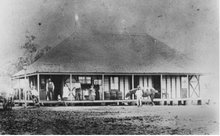It is also my favourite time of year because of the overlap of fruit seasons. Still available are the stone fruit of late summer while the colder weather fruit is coming onto the market. And in the grand scale of a state that sweeps from the frosts of the Granite Belt to the tropics of Northern Queensland we have a wide selection of tropical fruit available. Below is an impromptu still life of today’s fruit purchases. From the top roughly clockwise: papaya/pawpaw, bananas, granny smith apple, nectarine, plum, quince, pear, guava (our own), custard apple, royal gala apple.

After reading Barbara Kingsolver’s (a favourite fiction writer of mine) account of localism (Animal, Vegetable, Mineral: A Year of Food Life)– trying to consume only produce grown in a local area, I am pleased to say that every piece of fruit in the image is from Queensland. I’m just not sure that Kingsolver would agree with my definition of Queensland-grown as strictly local. In a state with an official land area of 1,730,648 square kilometres (22.5% of Australia’s 7,692, 024) localism becomes quite a broad definition.
While I’m sure that most of this fruit would not have been available to early migrants, I know that many of them started out growing pineapples, bananas and coffee. Settlers in the Granite
 Belt immediately saw its suitability for stone fruit, apples, cherries, pears and other fruit with high chill requirements. And of course, wine grapes. Pictured is the delightful Boireann Winery in/at The Summit – specialist makers of dry red wines. I love the juxtaposition of orderly vines and exotic deciduous trees with the soft colours of bush and the huge granite rocks.
Belt immediately saw its suitability for stone fruit, apples, cherries, pears and other fruit with high chill requirements. And of course, wine grapes. Pictured is the delightful Boireann Winery in/at The Summit – specialist makers of dry red wines. I love the juxtaposition of orderly vines and exotic deciduous trees with the soft colours of bush and the huge granite rocks.Although not the Americas, Queensland was definitely a new world for its new residents.

1 comment:
Luscious! Thanks for the photos.
Post a Comment